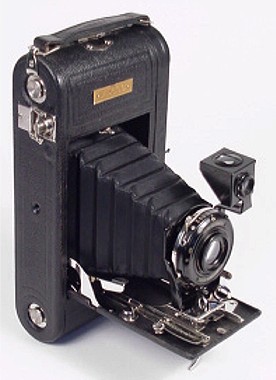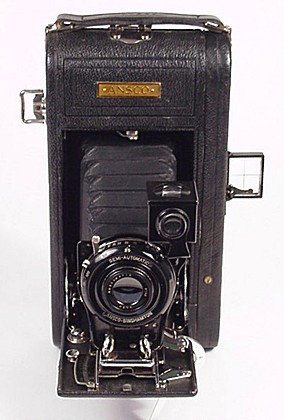
Semi-Automatic Ansco

Unassuming in appearance, looking much like any other folding rollfilm camera of the 1920s, a closer look reveals that this camera is a very unusual variant. The Semi-Automatic Ansco surprised the photographic world of 1924. It was no longer necessary to tediously wind film between shots, looking for the next frame number in the ruby red window. This camera, powered by a spring-wound motor performed the task automatically.
I presume that Ansco was less motivated by fears of carpal-tunnel syndrome disabling its customers than it was to offer the public a camera capable of capturing fleeting expressions and other elusive moments lost to the tedious manipulations of making a camera ready for its next exposure. Ansco advertised that this camera could shoot one exposure per second.
This is a camera of historical significance and yet, probably because it was not a big seller, it is not well-known among collectors. I haven't located the original selling price for the Semi-Automatic Ansco, but its sister model introduced one year later sold for 75 dollars. No wonder not many were manufactured.
Introduced in 1924, this was the world's first automatic advance camera for paper-backed rollfilm. In the Semi-Automatic Ansco a spring-motor drive advances the film. Since the camera's debut, other makers have incorporated automatic advance into their rollfilm cameras; the Hasselblad EL with its electric motor drive comes to mind, proving that the idea was not just frivolous. But over the years only a handful of automatic advance rollfilm cameras have been marketed.
The world's first marketed spring-motor drive camera for non-cine rollfilm is thought to be the French-made Japy Le Pascal camera of 1898. The Le Pascal is relatively unknown today. It took twelve 40 x 55mm exposures per roll of flexible film. Le Pascal film did not have a paper backing. The camera was on the market for just a few years and evidently did not sell well.
The first commercially successful spring-motor drive camera capable of taking still exposures on cine film was the French-made Debrie Sept, a combination cine and still camera, introduced in 1922. The Sept camera produced half-frame size photographs on 35mm cine film and was capable of taking stills and movies. The camera could also be adapted for use as a a movie projector.
The Sept camera was based on a patent purchased by Debrie from the Turin, Italy Fact company. Fact had introduced the patented Autocinephot camera a few years earlier. The Autocinephot did not sell well. But in its improved incarnation, the Sept, manufactured and marketed by Debrie was quite successful, selling for around twenty years.
As far as the Semi-Automatic Ansco's place in history goes, it was a significant achievement to have designed a strong and reliable spring-motor drive for the large and unwieldy paper-backed rollfilm of the day. Among factors complicating the task were the relative lack of precision of film spools; that rollfilm lacked edge perforations; that it was necessary to design a film-wind stopping mechanism to replace the red window; and that the large paper-backed rollfilm sizes typical of the era produced greater friction than cine film.
Ansco succeeded in overcoming these challenges. At least I can say that this camera in my collection is still in excellent working condition - and it's nearly 100 years old.

The Semi-Automatic Ansco has two viewfinders. An eye-level folding Newtonian viewfinder is mounted on the side of the camera, and a typical-for-the-period waist-level brilliant viewfinder is mounted on the lens standard.
The self-cocking Ilex shutter has settings for time, bulb, 1/25, 1/50 and 1/100 second. The Ilex Anscomatic lens has a maximum aperture of f/7.9 and stops down to f/64.
A special rollfim, No. 6A Automatic Ansco film created for use in this camera, delivered six 2 1/2 x 4 1/4 inch images per roll.
Notice that the folding bed is not centered in the camera body. The side of the camera with the Newtonian viewfinder is wider than its opposite side. This is where the gears for the spring-motor are located, and it is one of the subtle visual clues that distinguish this camera from its manually-powered relations.

The brilliant waist-level viewfinder has an unusual design. It can be rotated 90 degrees for vertical or horizontal photographs, as was typical for this type of finder. But the unusual part is, as the housing is rotated, the viewing mask rotates as well. The photo above shows the finder in mid-rotation. Notice that the viewing mask has rotated 45 degrees. With this design, the finder mask does a better job of framing the subject than the typical brilliant viewfinder. This is a subtle feature, possibly one that Ansco hoped would one-up Eastman Kodak in its competition for market-share.

The spring-motor winding key is visible in this side view. Notice the wind-key mounting plate is engraved with the word MOTOR. Here is another visual clue distinguishing this special camera from its folding rollfilm contemporaries.

The motor release lever can be seen extending up and out from the camera body, between the bellows and bed strut. In the Semi-Automatic model, the shutter and film wind are not coupled. To make an exposure, first the shutter is released, and then the motor release lever is pressed to advance the film to the next frame. Thus it is possible to make double and blank exposures.
Ansco released a second motor-drive camera, the Automatic Ansco, in 1925. In this model, the shutter and film advance were coupled, making unintentional double or blank exposures a thing of the past. This was a strong selling point for the Automatic model and Ansco emphasized this in their advertising.
Two Ansco patents related to the Semi-Automatic and Automatic Ansco models are listed on the Patents page. One of these patents lists the co-inventor as the very active camera designer Carl Bornmann. Mr. Bornmann developed cameras for Ansco and a predecessor company, Scovill and Adams Company for around three decades. Another Carl Bornmann camera and patent featured on this site is the 1920s Ansco Memo 35mm half-frame camera.
Other spring-motor drive still cameras on this site are the Bell & Howell Foton 35mm camera, ca 1948 and the Otto Berning Robot Junior 35mm camera, ca 1954.
For information on the Japy Le Pascal and Fact Autocinephot cameras, see the article Spring-Driven Cameras by Brunello Brunelli and Pierpaolo Cancarini in the August 2002 issue of Classic Camera. Classic Camera magazine was published quarterly by Zoom America, Inc.

|
Page created June 10, 2002;
updated December 20, 2020 |